  |

|
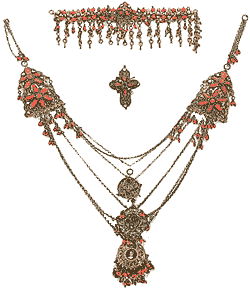
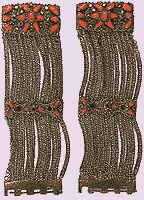
Fig. 7 Attractive parure
from Saframboli, Pontos. Gilded silver pectoral ornament
resembling the 'kordoni' of Attica; necklace, cross and
bracelets decorated with enamel and the characteristic coral.
19th century
Athens Benaki Museum, inv. nos Ea. 956, 952, 329, 946.
|
|
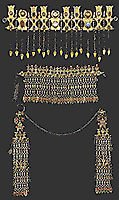
Fig. 8 Gilded jewellery from Epirus, .
Diadem necklace and earrings with stylized floral decoration, birds,
engraved motifs, chain pendants, turquoise, corals and rock-crystal.
Exquisite examples early gold work from Epirus.
18th century
Athens, Benaki Museum, inv. nos 668, 733, 573.
|
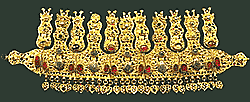
Fig. 9 Precious hammered gilt bridal diadem
from Pogoni (Epirus). The perforated finials end in heraldic birds
and a talismanic head. The diadem is decorated with agates, corals,
turquoise, glass-paste gems and silver elements in savati.
Late 18th century.
Athens Benaki Museum, inv. no. Ea 676.
|
|
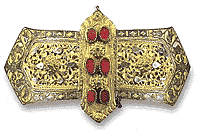
Fig. 10 Belt-buckle from Epirus with
hammered gilt ornamentation and a silver band of stylized tulips in
savati.
Mid-18th century.
Athens Benaki Museum, inv. no. Ea 1374.
|
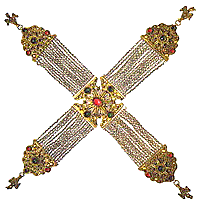
Fig. 11 Gilded silver 'kiousteki'
from Thessaly. l9th century. The decoration consists of many-petalled
filligree rosettes, coloured glass stones and double-headed eagles on
the clasp . `Kioustekia', characteristic chain ornaments, accompanied
the female Karagouna and Sarakaisani costume as well as the male
attire of brigand chiefs in Epirus and Mesolongi. According to use
they are divided into 'kioustekia' of the chest and waist.
Athens, Benaki Museum, inv. no. Ea 408.
|
The epic of Neohellenic jewellers was written in these times.
Silver was the medium par excellence, from which were wrought significant signed
and anonymous works, resplendent ecclesiastical silverware as well as intricate
secular ornaments, mirroring the aesthetic preferences of different sections of
society.
Jewellery making was essentially a workshop an associated with guild
organization. In addition to itinerant craftsmen who traveled throughout
Ottoman-held Greece, renowned centers of silver and goldsmithing developed: in
Epirus at Kalarrytes, Synako, Ioannina, Metsovo and Elvasan in Nonhern Epirus -
one oI the main streets of which was known as `the avenue of Greek goldsmiths';
in Macedonia at Monastiri and Nymphaion; in Thrace at Adrianople; in Thessaly;
in Central Greece at Lamia; in the Peloponnese at Stemnitsa.
Workshops were established on the islands too, in Crete,
Cyprus, the Aegean isles, on Zakynthos and Corfu, while the products of Greek jewelers
creating in Constantinople and Pontos - Saframboli, Argyroupoli and Trebizond -
were famed far and wide. `Mapping' the distribution of the Greek jewelers'
workshops reveals regional differences in designs and techniques.
A bearer of sociological, ideological and aesthetic orientations, jewellery also
functioned as an `insignium' of personal, social or community identity,
constituting an important testimony of the cultural reality.
In Neohellenic society jewellery was an integral part of the male
and the female costume at all levels of society. Impressive for its artistic
quality, regardless of whether it was of valuable material, it also reflected
the economic status of the family, as in the bridal parure, the decoration of
weapons, household ornaments and vessels. Artistic creation, and by extension
decoration and jewellery, are vital elements of everyday life, their presence
setting its seal on Greek civilization to this day. So is explained the
flourishing art of secular silver- and goldsmithing in Greece, with a host of
workshops dispersed throughout the country.
|
|


|
Greece jewellery pages Copyright ©
by Add
Information Systems. (Greece)
|
|
  |

